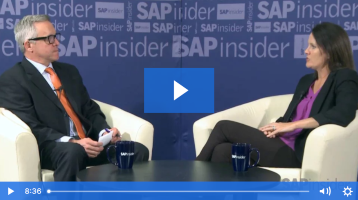Reduce payroll errors and system complexity by moving to the cloud
Key Takeaways
⇨ Payroll errors are costly, with organisations risking the loss of talent and potential legal compliance issues
⇨ Organisations are using several generations of SAP HCM solutions with end-of-life dates ranging from 2025 to 2040
⇨ Zalaris’ Mike Ellis says SAP SuccessFactors is supported indefinitely, while also providing scalability, flexibility and mobile accessibility
Customers are increasingly moving away from on-prem systems to the cloud mainly to avoid the costs of hardware upgrades and maintenance, as well as to get access to new innovations like generative AI.
An unexpected major benefit is reducing payroll errors, particularly with SAP SuccessFactors HCM Suite, according to Zalaris GVP Professional Services & EVP APAC, Mike Ellis.
Speaking at Mastering SAP Collaborate Melbourne in May this year, Ellis detailed the roadmap for organisations to migrate to the cloud, exploring key drivers, potential risks and best practices. This is the first of a two-part series – the first focusing on the benefits of moving to the cloud and the second part exploring the migration process itself.
Explore related questions
“What’s the cost of a payroll error? From a payroll perspective, keeping people happy comes down to making sure that your payroll is accurate and that you are not causing issues or running errors,” Ellis said.
“Stats from last year showed around 25 percent of people will look to change jobs if they have one payroll error experience, and that number jumps to 49 percent when they experience a second error.”
Ellis added that replacing those lost employees is expensive, as well as fixing those errors retroactively.
He also cited a survey from the Australian Payroll Association (APA), which found that 35 percent of the 2000 respondents (employers with staff numbers between 50 to 240,000) were satisfied with their payroll systems, saying it was “really low considering what payroll does for a business”.
The same survey found the respondents’ biggest risks for their operations in 2024 were having poor and incomplete data (34 percent) and upgrading technology (20.5 percent).
Depending on what an organisation has for an existing SAP human capital management solution, the deadline for upgrading varies from ECC (2025), ECC EHP or Business Suite (2027 and extended support until 2030) and H4S4 (2040). Ellis said the only version supported indefinitely is SAP SuccessFactors HCM Suite.
He cited the solution’s scalability, flexibility and mobile accessibility as benefits, along with native AI functionality, enabling organisations to adopt to evolving needs faster and foster a more agile and productive workforce.
Advantages over on-prem
According to Ellis, on-prem payroll solutions have fragmented models, resulting in high operational complexity, poor customer experience and increased error rates. They also rely on manual processes like spreadsheet-based data verification and reconciliation, which are not only time-consuming but also susceptible to accuracy and compliance issues.
Additionally, on-prem payroll does not provide enough insight into policy deviations and overtime, exposing the risk of facing potential legal issues and employee dissatisfaction. The user experience suffers, where employees are unable to update personal data conveniently or access pay information seamlessly.
Moving to SAP SuccessFactors means payroll is managed in a more agile way, with its ability to be run from anywhere. It also has automated processes to reduce time and effort required for payroll processing while also increasing the reliability of data.
The solution also adapts to changes in legislation to ensure compliance and reduce the risk of legal issues. SAP SuccessFactors also offers improved ease of access, end-user engagement, transparency, and collaboration among employees to boost the user experience.
SAP SuccessFactors also goes beyond the capabilities of enterprise resource planning (ERP) software like SAP S/4HANA, with functionalities such as core HR, payroll, talent management and advanced analytics aimed to meet dynamic HR needs and improve employee experiences. It is also flexible, compared to SAP S/4HANA’s fixed nature, allowing to scale up or adapt HR needs as business needs evolve.
The second of this two-part series will go into the specifics on how to migrate to the cloud, including the specific upgrade options based on what SAP HCM solution is in place; options for Time Management; deployment options (greenfield, brownfield and hybrid approaches); and the specialised tools that help simplify migration and maintenance in SAP environments.




